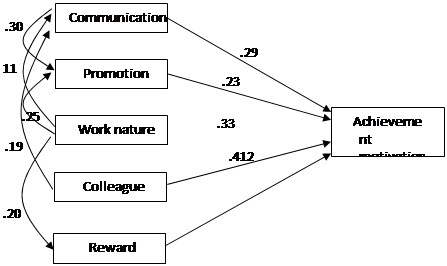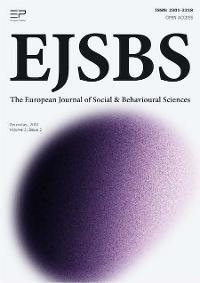Abstract
Nowadays, a labor force with the knowledge and skills necessary to operate in an increasingly complex work environment is a key component of agricultural development. Agricultural universities have an important role in the growth and development of agriculture. While agricultural faculty members’ performance affect educational quality, it is imperative to pay attention to faculty members and their achievement motivation as an important factor in educational process. The purpose of this study was to investigate factors influencing achievement motivation of agricultural faculty members. A descriptive and correlation design was used for the research with data collected using questionnaire. The statistical population of this study included faculty members of University College of Agriculture and Natural Resources, University of Tehran. A sample of 65 members was selected using random sampling method. Reliability and validity of instrument were determined through opinions of faculty members and application of Cronbach's Alpha. The data were analyzed by using descriptive and inferential statistics. Data were analyzed descriptively and inferentially using SPSS for Windows, version 11.5. The descriptive statistics included frequencies and percentages, while inferential statistics included correlation coefficient and t-test. The findings revealed that about 90.8 percent of faculty members had high achievement motivation and only 9.2 percent of respondents had medium achievement motivation. The findings showed that there were significant correlation between achievement motivation and variables including work nature, colleague, communication and reward.
Keywords: Achievement motivation, faculty member, agriculture, reward
Introduction
Nowadays, trained labour force has central role in labour productivity as a major component of agricultural development (Hunt, 2000). Therefore, employment of the newly graduating students who majored in agriculture related subjects at universities and other higher education institutions is one of the most effective solutions of addressing demand for trained and skilled labour force (Okutsu et al., 2004). In this regard, Universities have a direct role in poverty alleviation (Atchoarena & Holmes, 2005) and today, more than ever before in human history, the wealth or poverty of nations depends on the quality of higher education (Malcolm Gillis, 1999; as cited in Asadi et al., 2011).
In higher education institutions, faculty members are known as an important component of educational system, and their better performance will be affected development of the country (Mazinani, 2001). Also, faculty members play an important role in increasing motivation of students to strive for higher learning. Since lack of faculty members’ motivation will result in low performance, it is imperative to pay attention to faculty members’ motivation. Woolfolk (2001) defined motivation as an internal state that arouses, maintains and directs behaviour. Motivation is the process whereby goal-directed activity is begun and sustained (Pintrich & Schunk, 2002).
Achievement motivation can be defined as the desire to excel or an innate force in which an individual wants to succeed (Woolfolk, 2001). People who demonstrate high achievement motivation are driven to achieve. Chen (2007) found that there were positive correlation between achievement motivation and job satisfaction.
Since agricultural universities contribute to the growth and modernization of agriculture and agricultural faculty members’ performance will affect educational quality, the main purpose of this study was to investigate factors influencing achievement motivation of agricultural faculty members. The special objectives of the study were:
-Identifying faculty members’ achievement motivation;
-Correlation for independent variables and the score of achievement motivation;
-Path analysis to explain variation in the extent of faculty members’ achievement motivation by independent variables.
Materials and Methods
Population and sample
The statistical population of this descriptive-correlation study included faculty members of the University College of Agriculture and Natural Resources, University of Tehran (N= 203). A sample of 65 members (using Cochran's formula) was selected by use of random sampling method.
The instrument used to collect data was a questionnaire. The first section of questionnaire contained demographic characteristics of respondents and the remaining sections consisted questions related to research objectives. For assessing achievement motivation of faculty members, Hermans (1970) achievement motivation questionnaire was applied.
Validity of the questionnaire was established by a panel of experts consisting of faculty members. Reliability of the instrument was measured by calculating Cronbach's Alpha coefficient, a measure of internal consistency. The reliability for achievement motivation scale was .86, found to be good (George & Mallery, 2003).
Data were analyzed using Statistical Package for the Social Sciences (SPSS) version 11.5. Descriptive and inferential statistics were used to analyze the collected data. Descriptive statistics included frequency, percentage, mean, and standard deviation, while inferential statistics included Mann-Whitney U test, correlation coefficient, and path analysis based on a series of regressions.
Results
Demographic information of respondents
About 93.8 percent of the respondents were male and 6.2 percent were female. Respondents were on average 46 years old and the mode was in the class of the age 41-50 years (43.1%). While, 23.0, 30.8, and 3.1 percent of respondents aged <41, 51-60, and >60 respectively. About half of the respondents were associated professors (41.5%).
The findings revealed that about 90.8 percent of faculty members had high achievement motivation and only 9.2 percent of the respondents had medium level of achievement motivation. The Mann-Whitney U test was used to examine probabilistic differences between achievement motivation and gender. The Mann-Whitney U was 86.000 ns showed that there was no difference between achievement motivation of male and female faculty members.
Correlation for independent variables and the score of achievement motivation are presented in Table 1.
It is recognizable that communication, promotion, work nature, and colleague (p<.01) and reward (p<.05) were positively and significantly correlated with the score of achievement motivation.
In order to explain variation in the extent of faculty members’ achievement motivation, path analysis was conducted. Fig. 1 illustrates the results of the path analysis. In the path analysis, each variable was regressed in turn onto the set of variables preceding it in the model. For example, when testing the possible influence of independent factors on achievement motivation, a regression analysis was performed predicting achievement motivation from communication, promotion, work nature, college, and reward. Separate linear regression analyses were conducted and communication, promotion, work nature, college, reward, and achievement motivation were dependent variables. By conducting these types of regressions, we created an output path diagram by drawing an arrow for each statistically significant relation. Numbers on the arrows are standardized coefficients.

Table 2 shows the standardized total effects, direct and indirect effects associated with each of the five factors. An indirect effect reflects the impact a determinant has on a target variable through one or more other intervening variables in the model. A total effect on a given variable is the sum of the respective direct and indirect effects. The effect sizes with values less than 0.1 were considered small, those with less than 0.3 were medium, and values with 0.5 or more considered large (Cohen, 1988).
The most dominant determinant of achievement motivation was work nature with a total effect of .505. This was followed by colleague with a total effect 0.469.
Conclusion and Recommendations
Since education play a vital role in the promotion of cognitive, affective and practical competence in individuals, it is important that faculty members who are responsible for helping the students acquire the knowledge and skills essential for agricultural development, be effectively motivated. Hence, this study investigated factors influencing achievement motivation of agricultural faculty member. The findings showed that there were significant correlation between achievement motivation and variables including promotion, work nature, colleague, communication and reward. The result of path analysis showed that the most dominant determinant of achievement motivation was work nature.
Faculty members who are highly motivated will feel happier and are more willing to work for the organizations. The solution to increase the level of achievement motivation is to improve those working conditions and facilities which are required for maintaining the morale of the faculty members. Ochitwa (2002) pointed out that organizational climate can arouse staffs’ natural motivations. He stated that some climates could lead to frustration of staff, while others can energize the work environment. According to the findings, it is imperative that Colleges of Agriculture understand the needs of their faculty members and provide what is best for them. Constant appraisal programs and appreciation should be given to motivate faculty members. Also, it is important that Colleges of Agriculture create a learning organization culture in the working environment.
References
Asadi, A., Varmazyari, H., Kalantari, K., & Sadati, S. A. (2011). The Study of agricultural students' effective entrance in agricultural fields after graduation: case study of students of University College of Agricultural and Natural Resources, Tehran University, Iran. Research Journal of Applied Sciences, Engineering and Technology, 3(1), 1-9.
Atchoarena, D., & Holmes, K. (2005). The role of Agricultural Colleges and Universities in rural development and lifelong learning in Asia. Asian Journal of Agricultural Development, 2(1-2), 15-24.
Chen, L. A. (2007). Job satisfaction among information system (IS) personnel. Computer in Human Behavior, 1, 105-118. DOI:
George, D., & Mallery, P. (2003). SPSS for Windows step by step: A simple guide and reference. 11.0 update (4th ed.). Boston: Allyn & Bacon.
Hermans, H. J. M. (1970). A questionnaire measure of achievement motivation. Journal of Applied Psychology, 54(4), 353-363. DOI:
Mazinani, A. (2001). Investigating the situation of produce and use of scientific information from faculty members. Rahyaft, 25, 196.
Ochitwa, O. (2002). A study of the organizational climate of high and low adopter elementary schools in Saskatchewan. Group and Organizational Management, 24(4), 96-100.
Okutsu, M., Tomosue, T., Kataoka, T., & Sawada, J. (2004). Agriculture and employed labor force: the current situation and future direction summary. The Japan Institute for Labour Policy and Training Research Repor, No. L-2.
Pintrich, P. R., & Schunk, D. H. (2002). Motivation in education: Theory, research, and applications (2nd ed.). Englewood Cliffs, NJ: Prentice-Hall.
Woolfolk, A. (2001). Educational Psychology. (8th ed.). Boston, MA: Allyn and Bacon.
Copyright information

This work is licensed under a Creative Commons Attribution-NonCommercial-NoDerivatives 4.0 International License.


